Best Family Beach Vacations 7 Activities Your Kids Will Love
Last updated on June 20th, 2025 at 04:36 pm
Three summers back, I made a rookie mistake. Packed the minivan with enough electronic gadgets to power a small city, thinking I’d need them to keep my kids entertained during our week at Ocean City. What happened next? My 7-year-old daughter spent the entire first morning digging a hole. Not building anything fancy – just digging. For three straight hours. It was the moment I realized that the best family beach vacations aren’t about screens or schedules they’re about simple joys, like sand between your toes and endless digging missions.
By noon, she’d recruited her little brother and two random kids from the beach next to us. They’d created this elaborate network of tunnels and pools, complete with a water delivery system using old yogurt containers. Not one tablet or phone in sight.
That’s when it hit me – I’d been overthinking beach vacations for years. Kids don’t need elaborate entertainment when you’ve got sand, water, and endless possibilities right in front of them.
After fifteen years of family beach trips (and plenty of trial and error), I’ve figured out what actually works. These seven activities have saved countless vacation days and created memories my kids still talk about. More importantly, they’re things you’ll genuinely enjoy doing alongside your children.
Table of Contents
Why the Best Family Beach Vacations Work Magic on Families
Here’s something interesting I’ve noticed: put the same kid who complains about walking to the mailbox on a beach, and suddenly they’re hiking for miles looking for the perfect shell. There’s something about ocean air that transforms energy levels.
Beach destinations naturally solve problems we parents deal with constantly. Screen time battles? Gone. Kids move from sunrise to sunset without being asked. Sibling arguments? Hard to fight when you’re both focused on building something together in the sand.
The real beauty is how beaches work for every age at once. Your toddler’s having a blast filling buckets while your teenager’s learning to surf. Meanwhile, you’re reading an actual book for the first time in months.
But here’s what nobody tells you – beach vacations can go sideways fast if you don’t have a few solid activities ready. Trust me, I’ve lived through the “I’m bored” meltdowns when the weather turns or the initial excitement wears off.
The 7 Activities That Never Fail
1. Sand Architecture That Goes Beyond Basic Castles
Forget everything you think you know about sandcastles. We’re talking about creating entire civilizations here.
During our trip to Myrtle Beach in 2022, my son decided he wanted to build a dinosaur instead of a castle. Started with a basic shape, then spent hours adding details – scales made from shell impressions, eyes created with smooth stones, even a mouth you could stick your arm into.
By day three, he was taking construction requests from other families. One dad asked for a sports car. Another family wanted a replica of their house. My kid became the unofficial beach architect, and honestly, he was glowing with pride.
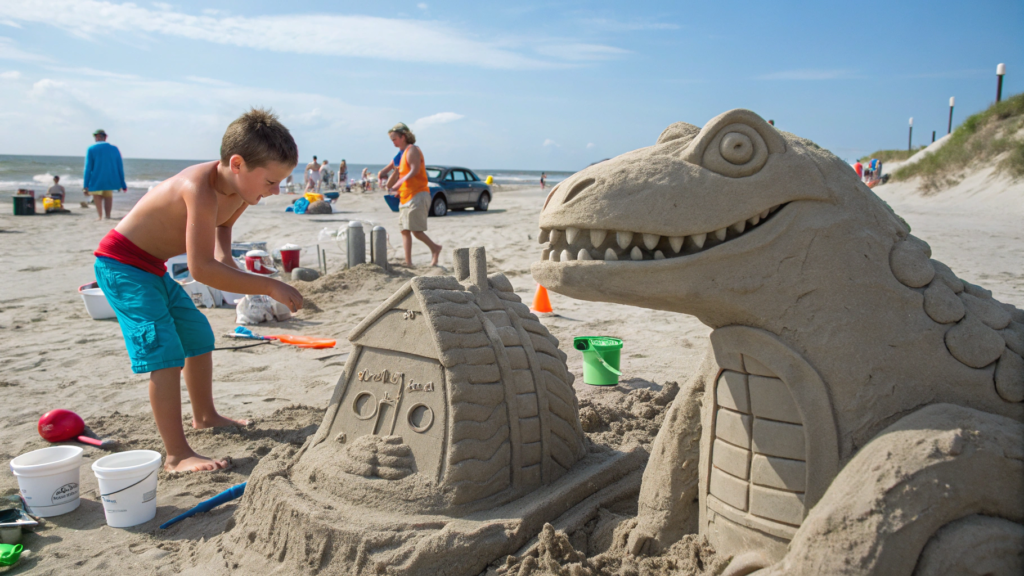

What makes this work:
- Start with basic shapes, then add personality
- Use different tools (not just buckets) – yogurt containers, coffee cans, even hands work great
- Encourage storytelling – who lives in this castle? What’s the dragon’s name?
- Take progress photos throughout the day
The secret ingredient? Bring a spray bottle filled with water. Keeps everything workable and extends building time by hours. Also pack a variety of containers – different sizes create more interesting architecture than identical buckets.
2. Detective Work That Keeps Kids Engaged for Hours
This started by accident during a particularly chaotic morning when I needed twenty minutes to actually drink my coffee. Handed my 5-year-old a small bucket and asked her to find “five things that are white, three things smaller than her thumb, and something that makes noise when shaken.”
She disappeared for an hour. Came back with a collection that would make a marine biologist proud – different shell types, smooth glass pieces, dried seaweed that crackled, even a piece of driftwood shaped like a seahorse.
Age-appropriate challenge ideas:
- Little ones (3-6): Find things by color, size, or texture
- School age (7-11): Specific items like “find five different shell patterns” or “collect things that tell a story”
- Older kids (12+): Photo challenges like “capture three examples of beach erosion” or “document five different bird behaviors”
The key is making it feel like exploration, not homework. I’ve learned to phrase challenges as mysteries to solve rather than lists to complete. “I wonder if we can find evidence that a storm happened here recently” works way better than “find three pieces of storm debris.”
3. Water Games That Don’t Require Athletic Skills
Not every family has future Olympic swimmers, and that’s perfectly fine. Some of our best water memories involve the simplest activities.
Take beach bowling – we set up plastic bottles filled with sand, then try to knock them down with a soft ball while standing in knee-deep water. Sounds easy? Try it when waves are constantly moving your feet around. Even my uncoordinated brother-in-law was laughing hysterically while trying to stay upright.
Activities everyone can handle:
- Water limbo using a pool noodle (way harder than it sounds)
- Follow the leader through shallow waves
- Beach ball keep-up while standing in water
- “Red light, green light” with waves adding extra challenge
Safety reality check: I stay within arm’s reach of non-swimmers, period. And those colorful foam noodles? They’re toys, not safety devices. Real life jackets for anyone who needs them, no exceptions.
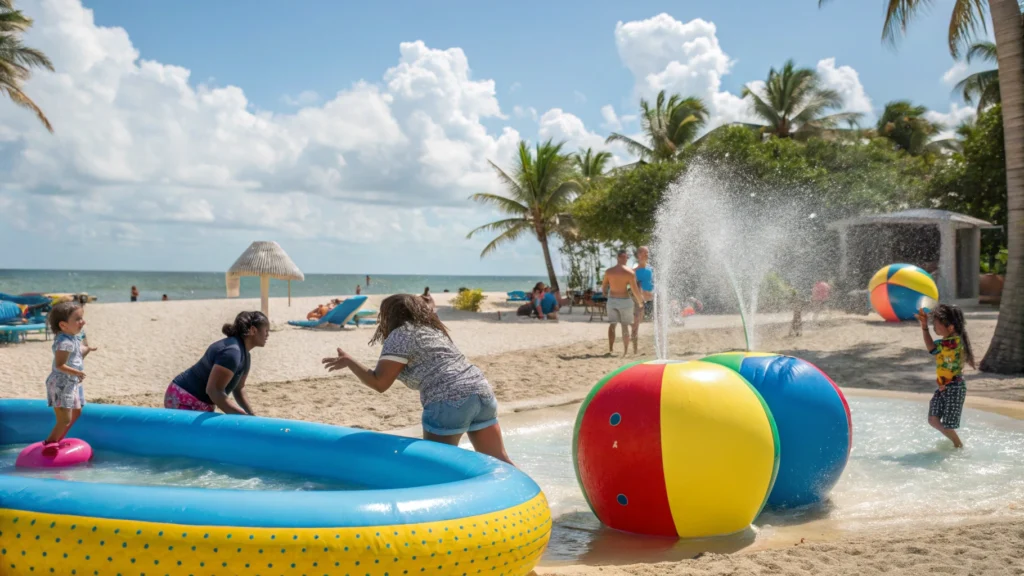

One thing I wish I’d known earlier – water shoes are worth every penny. After one summer of dealing with “my feet hurt” complaints every ten minutes, I invested in decent water shoes for everyone. Problem solved.
4. Becoming Beach Scientists
This activity turns every walk into an adventure, and kids naturally become fascinated with what they discover.
Last spring at Rehoboth Beach, we found what looked like tiny glass marbles scattered along the high tide line. Turns out they were fish eggs – something I’d never seen before in twenty years of beach going. That discovery led us to spend the next two hours examining everything we’d normally walk past.
Simple investigation techniques:
- Examine shells for tiny holes (hermit crab homes)
- Follow bird tracks to see where they lead
- Look for patterns in how waves arrange shells and stones
- Study tide pools during low tide for living creatures
Tools that enhance the experience:
- Magnifying glass for detailed inspection
- Small containers for temporary specimen collection
- Field guide or smartphone app for identification
- Camera for documenting discoveries
Important rule we follow: observe and photograph, but leave living creatures where we find them. We learned this after my nephew “rescued” a sea anemone that didn’t survive the journey back to our beach chairs.
5. Beach Olympics That Include Everyone
Traditional sports get tricky with mixed ages, but beach versions naturally level the playing field. Sand makes everything harder, which somehow makes it more fun for everyone.
Our family tournament evolved over several years. Started with basic events like “longest frisbee throw” and “fastest sandcastle,” but now includes categories like “most creative beach art” and “best seaweed sculpture.”
Events that work for all ages:
- Sand long jump (who cares about records when landing is soft?)
- Beach ball volleyball with no net
- Kite flying contests (distance, tricks, or just staying airborne)
- Relay races involving buckets, water, and lots of splashing
The real winner? Everyone. We hand out prizes made from beach finds – shell necklaces, driftwood trophies, or certificates written in the sand. Kids love the competition, but it’s low-pressure enough that nobody gets upset.
Pro tip: bring backup prizes. Nothing derails beach Olympics faster than arguments over who gets what. Having extra “awards” saves the day every time.
6. Creating Art That Disappears (And That’s Perfect)
There’s something freeing about making art you know won’t last forever. Kids seem to understand this instinctively and pour themselves into temporary creations.
My favorite memory involves a massive collaborative mural my extended family created over three days. Started when my niece began arranging shells in patterns. By the final day, we had a 20-foot spiral made from stones, shells, seaweed, and driftwood that told the story of our vacation.
Projects that capture imagination:
- Stone balancing sculptures
- Seashell mandalas arranged in intricate patterns
- Sand painting using colored sand or crushed shells
- Driftwood installations that work with natural beach shapes
Materials worth packing:
- Small containers for organizing found materials
- Twine for connecting driftwood pieces
- Washable markers for temporary rock decoration
- Camera to preserve ephemeral art
The beauty of beach art is its temporary nature. Kids learn to appreciate the process over the product, and there’s no pressure to preserve everything. When waves wash away their masterpiece, they just start something new.
7. Evening Rituals That End Days Perfectly
Sunset time transforms beach energy from active to peaceful, and smart parents take advantage of this natural transition.
Our evening routine started simply – pack dinner and eat on the beach while watching the sun go down. But it evolved into something more meaningful. We began sharing daily highlights, which turned into storytelling, which became a tradition my kids request at every beach trip.
Elements that create magic:
- Simple finger foods that won’t get sandy
- Battery-powered lanterns for after dark
- Comfortable seating (sand gets cold once the sun disappears)
- Activities that encourage conversation
Food that works:
- Sandwiches cut into fun shapes
- Fresh fruit that provides hydration
- Trail mix for sustained energy
- Thermoses with warm drinks for cooler evenings
One unexpected discovery: glow sticks create amazing evening entertainment without fire hazards. Kids love them, they’re safe around sand and water, and they provide just enough light for after-dark exploration.
Making It Work for Different Ages
Toddlers (2-4 years): Keep activities short and sweet. Pack twice as many snacks as you think you’ll need, and always have backup plans for meltdowns. Their attention spans are limited, but their enthusiasm is contagious.
Elementary ages (5-10): This is the golden age for beach activities. They’re old enough to help with projects but young enough to get genuinely excited about simple discoveries. Don’t overschedule – some of their best memories will happen during unplanned moments.
Tweens and teens (11+): Give them cameras and challenges that feel grown-up. They still love building things in the sand (even if they won’t admit it), but frame activities as “helping the little kids” if they’re feeling too cool to participate directly.
Avoiding Common Beach Vacation Mistakes
After years of learning the hard way, here are the pitfalls I help families avoid:
Overpacking entertainment: Kids need less than you think. Basic tools for sand play, a few balls, and their imagination handle most situations.
Underestimating sun exposure: Cloudy days can be the worst for sunburn because you don’t feel the heat. Reapply sunscreen every two hours, no matter what.
Forgetting hydration: Salt air and sun dehydrate faster than you’d expect. Pack water bottles for everyone and refill them regularly.
Trying to stick to rigid schedules: Beach time has its own rhythm. Fighting against it creates stress for everyone.
Budget-Smart Beach Vacation Planning
Best family beach vacations don’t require unlimited budgets. Some of our most memorable trips have been the most affordable ones.
Money-saving strategies:
- Vacation rentals with kitchens save hundreds on restaurant meals
- Public beaches offer the same sand and waves as expensive resorts
- Dollar store supplies work perfectly for most beach activities
- Renting equipment for one day lets you test before buying
What’s worth spending money on:
- Quality sunscreen (cheap versions don’t protect properly)
- Decent water shoes for everyone
- Comfortable beach chairs for parents
- A large beach umbrella for shade
The truth is, kids don’t care about luxury accommodations. They care about having fun in the sand and making memories with family. Save money on fancy hotels and spend it on experiences instead.
When Beach Plans Go Sideways
Even perfect plans sometimes crash into reality. Weather changes, kids get cranky, someone gets hurt, or equipment breaks. Having backup strategies makes all the difference.
Rainy day alternatives:
- Indoor scavenger hunts in your accommodation
- Beach-themed craft projects with supplies from previous days
- Movie marathons featuring ocean adventures
- Planning tomorrow’s beach activities together
Dealing with meltdowns:
- Pack snacks and drinks for energy crashes
- Bring favorite comfort items for overwhelmed little ones
- Have quiet activities ready for overstimulated kids
- Remember that some days just don’t work out, and that’s okay
Creating Lasting Memories
The best family beach vacations aren’t perfect – they’re real. Kids remember the day Dad tried to surf and face-planted spectacularly. They remember the morning Mom found the perfect shell and did a happy dance. They remember working together to dig the deepest hole anyone had ever seen.
Document these moments, but don’t let documentation take over the experience. Take photos, but also put the camera down and build sand sculptures. Collect shells, but also just sit and watch waves roll in.
Most importantly, embrace the chaos. Beach vacations with kids are messy, unpredictable, and exhausting. They’re also some of the most joyful experiences families can share.
The magic happens in unexpected moments – when your teenager actually laughs at your terrible beach puns, when your toddler discovers hermit crabs for the first time, when everyone works together to save a sandcastle from incoming waves.
These are the stories you’ll tell for years, the memories that make all the sandy car seats and sunscreen-covered everything worthwhile. Because at the end of the day, the best family beach vacations aren’t about perfect execution – they’re about perfect moments that happen when families play together by the sea.
What beach memories are you hoping to create this year? Share your plans in the comments – I love hearing about families discovering the magic of beach vacations for the first time!

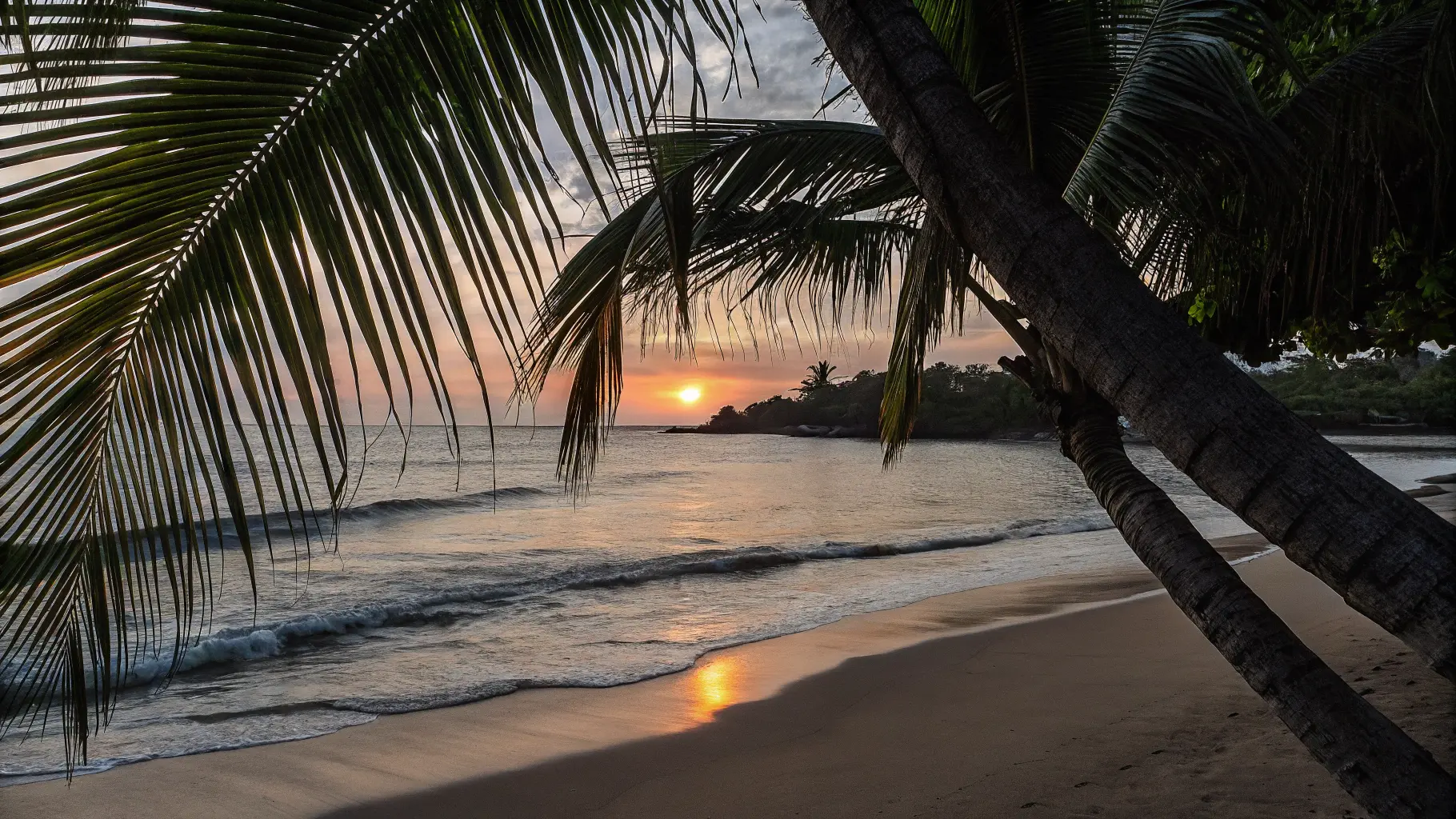
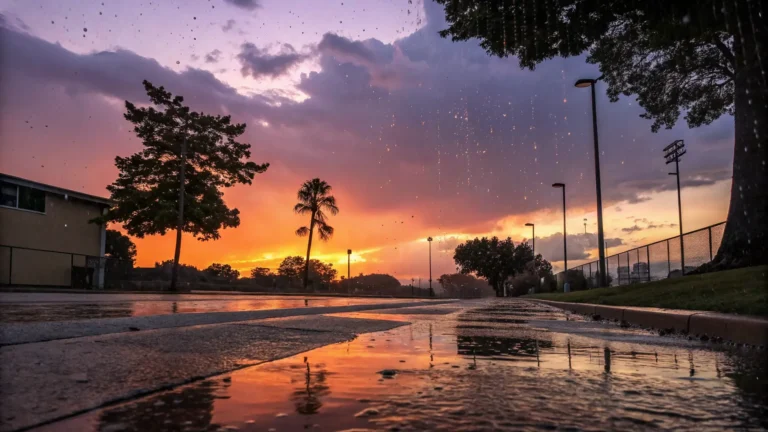

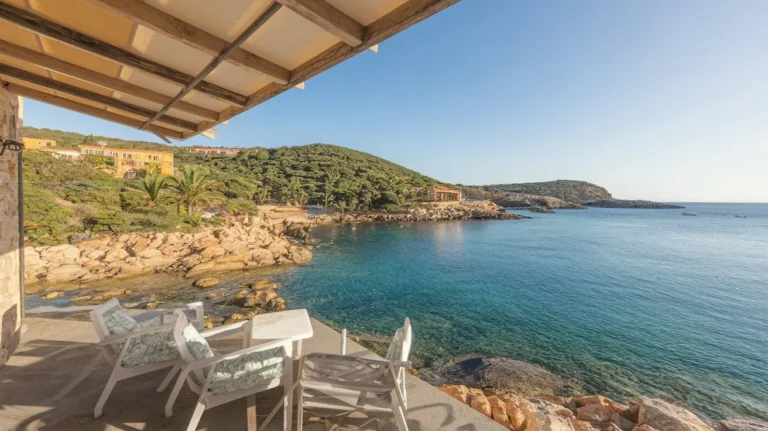



One Comment